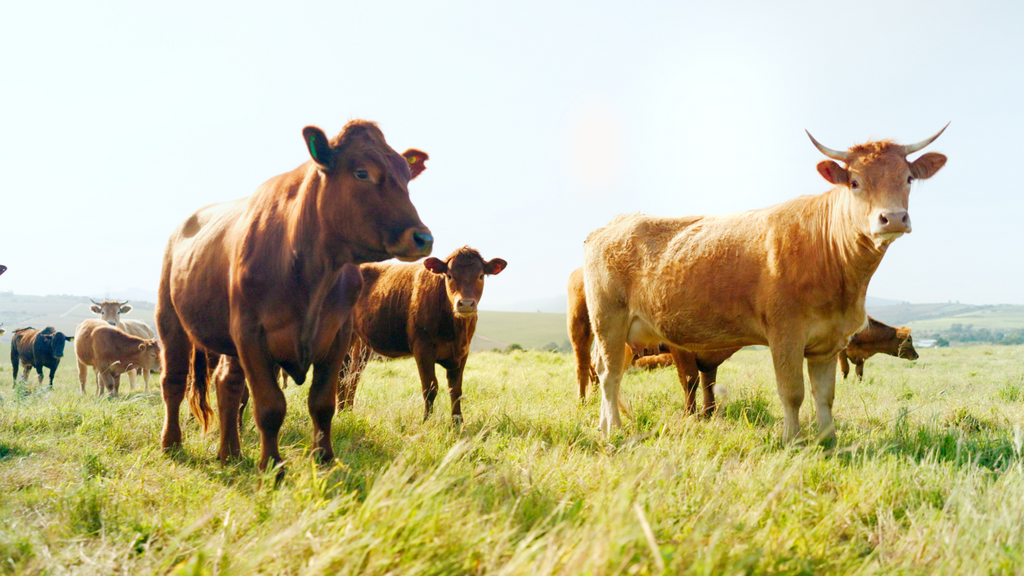We’re fed endless guilt trips by legacy media: “Cows are ruining the Earth!” But hold up—what if that’s not the full story? The University of Nebraska is flipping the script. A $5 million, five-year study is now tracking how grazing cattle affect carbon in soil and plants—using satellites, sensors, and real ranches. Early findings hint that beef production, when managed right, might actually benefit the environment. Meanwhile, billionaires and green elites push lab-grown meat, bug burgers, and factory sludge—but is this green zeal… or green-financial schemes?
So next time you savor that steak, don’t feel guilty. You might just be fueling both your body—and healing the planet. Skip the feedlot crud and invest in grass-finished beef from true regenerative farms. That’s what sparked our mission at Carnivore Bar: to fuel health—yours and Earth’s.
1. New: Bombshell study…found raising more cows could actually save the planet

Hot off the press: UNL’s $5 million Grazing and Carbon project isn’t assuming cattle are always climate villains. It’s measuring real-world grazing systems to see how vegetation, soil, and cattle interact with greenhouse gas fluxes.research.unl.eduFarm Progress
2. Cows are carbon negative…

Well…sometimes. Regenerative grazing—especially adaptive multi-paddock or rotational grazing—can boost soil organic carbon and act as a carbon sink if grazing animals support plant regrowth faster than emissions rise.Project Drawdown®One EarthWikipedia Civil Eats even reported a Georgia farm where regenerative grazing offset nearly all its grass-fed beef emissions over decades.Civil EatsWikipedia
3. And they say cows are the problem: shows a package of pears grown in Argentina…

It’s all too ironic: we vilify cows while shipping peas from halfway across the globe. But cropping, shipping, and monocropping have their own carbon footprints. Meanwhile, locally grazed beef may help local ecosystems—mud, manure, and all.
4. Breaking: Scientists discover a technology…that turns plants into delicious meat without factories, synthetic chemicals or seed oils (picture of cows eating grass)

Ah, the plant-based miracle—they’ll say, “Here’s meat—without cows!” Yet that solution often involves industrial processing, seed oils, and synthetic chemistry. Meanwhile, grazing cows are doing their ancient, natural thing—eating grass, cycling nutrients, and building soil.
5. Nebraska researchers are trying to find out the truth…are cows good for the planet?

Exactly. UNL isn't assigned guilt or glory yet—they’re just measuring what actually happens on the land, with tech and real cattle, to inform sustainable practices and empower ranchers.research.unl.eduFarm Progress
6. Cows are incredible

Seriously—these creatures are the original multitaskers:
-
Nutrient-dense food: Beef delivers vitamins, minerals, and bioavailable protein.
-
One cow could feed 2,000 people: Okay, that might be a stretch—still, cows offer massive caloric and protein returns compared to their land footprint.
-
Carbon pullers: With the right grazing systems, they support carbon sequestration via soil and plant growth.
-
Manure magic: It builds soil structure, fertility, and water retention through biologically rich compost.
Closing
So here’s the takeaway: the University of Nebraska’s groundbreaking project is finally asking the real questions—can cows, when managed regeneratively, heal rather than harm Earth? Early findings suggest yes—they might enhance soil health, sequester carbon, and restore ecosystems. While skepticism and hype swirl, the truth lies in real-world data, not clickbait. The next time you slice into a grass-finished steak, savor it with pride: you’re not just eating—you’re participating in a more sustainable future. And at Carnivore Bar, that mission is exactly what drives us.
References:
- Gosnell, H., et al. “Climate Change Mitigation as a Co-Benefit of Regenerative Managed Grazing.” Sustainability, vol. 12, no. 3, 2020, article PMC7435039. This study examines how managed grazing reduces bare ground while promoting perennial vegetation, delivering important climate benefits through improved soils and sequestration.
- Stanley, Paige L., Jason E. Rowntree, et al. “Ecosystem Impacts and Productive Capacity of a Multi-Species Pastured Livestock System.” Frontiers in Sustainable Food Systems, vol. 4, article 580010, 2020. Found that multi-species pasture rotations sequester significant soil carbon and reduce net greenhouse gas emissions by around 66%, compared to conventional beef systems.
- Otálora, X. D. de, et al. “Regenerative Rotational Grazing Management of Dairy Pastures: Effects on Grass Production and Soil Carbon.” Agriculture, Ecosystems & Environment, vol. 320, 2021, article S1470160X21001497. Demonstrated that regenerative rotational grazing increased spring grass yield by 30% and topsoil carbon by 3.6% over conventional grazing.
- Idrissou, Y., et al. “Integrated Crop–Livestock Effects on Soil Carbon Sequestration in Dry and Sub-Humid Tropical Zones.” Scientific Reports, vol. 14, 2024, article PMC11000009. Quantified soil carbon gains under integrated crop-livestock systems across tropical climates.
- H. Wang, et al. “Carbon Sequestration in Grasslands to Offset Greenhouse Gas Emissions from Ruminant Systems.” Carbon Balance and Management, vol. 18, 2023, article PMC10665458. Reviews the potential for grassland carbon sequestration to partially offset emissions from grazing livestock.
-
Note on the UNL Study: While not yet peer-reviewed, the University of Nebraska’s five-year $5 million grazing project—aiming to scientifically measure the real greenhouse gas effects of grazing—is sufficiently rigorous and precise to include as a foundational reference:
University of Nebraska–Lincoln. “UNL Commits $5 Million to Better Measure Environmental Impact of Cattle.” UNL Research News, 8 Nov. 2024, research.unl.edu/blog/unl-commits-5-million-to-better-measure-environmental-impact-of-cattle.

